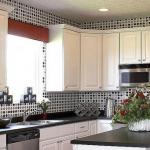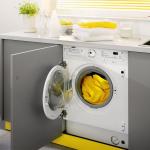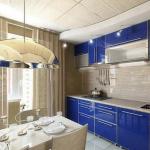What wallpaper is better to choose for the kitchen? This question is always relevant when it is necessary to carry out repairs in the kitchen. The walls of this room are the backdrop that frames the kitchen space. Wallpaper can visually enlarge or make a kitchen space smaller, add charm to the kitchen, and also set the tone for further decoration. In addition to aesthetic characteristics, kitchen wallpaper must provide the ability to resist moisture, grease, burning, and also be wear-resistant.
What influences the choice?
To choose the wallpaper that suits your kitchen, you should consider a number of factors:
- type of wallpaper;
- design style and area of the room;
- financial opportunities;
- your preferences of shades and colors;
- environmental friendliness;
- functional purpose of the kitchen.

If the kitchen is often hot, humid, and also difficult to keep the space clean when cooking, then moisture resistance, wear resistance and the ability to stay clean are added to these points. In some cases, the degree of illumination, the presence of niches, ledges, and the like are important.
The industry today seeks to meet the various needs of consumers, so there are many types of wallpaper. Therefore, it is important to know in advance which wallpaper is better to glue in the kitchen. This will allow you to enjoy the result and not worry that your wallpaper will quickly become unusable.
paper wallpaper
This type of wallpaper has a number of advantages:
- cheapness;
- environmental friendliness;
- variety in patterns and colors.

Paper wallpapers are not the best solution for the kitchen, because they are highly susceptible to mechanical damage. Plus, they can't be washed. However, they can be used to decorate the walls around the stove, sink and ceramic tiled work area. The combination of two different finishing materials will give the kitchen an original look. The tile and paper coating can be the same color, but different shades.

Such repairs are quite practical and economical. Of course, paper wallpapers are not durable, but they are cheap. Thanks to this, you can often update the appearance of the kitchen, however, this is only suitable for those who like to do plywood.
Non-woven wallpaper
These wallpapers have a textured non-woven backing, which is intended for further painting. Vinyl wallpaper on a non-woven base is often referred to as this type, but this is not very true. Interlining is generally similar to paper, it is made of cellulose, as well as polymers that bind it. However, it has a number of advantages over the usual paper wallpaper:

- easy to glue, the wallpaper does not move apart and does not bubble. Glue for pasting is applied only to the wall. This option is especially relevant for beginners and repairs in a small apartment;
- dense, suitable for walls with bumps and cracks;
- able to withstand several repaints, which allows you to often change the background of the kitchen;
- fire resistant;
- breathable, so you can not be afraid of the appearance of mold;
- wear-resistant;
- do not fade for a long time;
- moisture resistant and easy to clean.

Textured wallpaper for the kitchen
There are such wallpapers and cons:
- textured surfaces collect dust more, as a result of which it will be necessary to wash the walls or vacuum from time to time;
- the upper relief layer is easily damaged, therefore, if there are children or animals in the apartment, it is recommended to finish the lower part of the wall with tiles or panels;
- The need for painting can be both an advantage and a big disadvantage.
Vinyl wallpapers
Such wallpapers have a non-woven or paper base with a decorative vinyl coating on top. It comes in varieties: "kitchen" or smooth vinyl, foam vinyl, hard vinyl and flat vinyl. So what kind of wallpaper is better to glue in the kitchen? Foamed vinyl is not suitable for cladding a kitchen room due to its low moisture resistance. Other types are great for decorating kitchens.

Vinyl wallpaper has many advantages:
- they are moisture resistant and washable, so that such a coating can be safely wiped and cleaned;
- have a high density, which makes it possible to mask minor imperfections of the walls;
- less susceptible to various mechanical damage, wear-resistant;
- do not burn out;
- can imitate various natural materials, ranging from fabric to snakeskin.
Flaws:
- air tightness, as a result of which it is recommended to ventilate the room from time to time;
- if the vinyl layer is not dense enough, then it is necessary to pre-coat the walls with plaster to ensure its uniformity;
- Vinyl wallpaper is somewhat more difficult to glue than non-woven. This is due to the fact that the glue is applied to the canvas, while the canvas is stretched. As a result, they can "sit down" after gluing.
- high price.

We have listed which wallpaper is best for the kitchen, but there are other types of wallpaper that buyers may stare at.
Other types of wallpapers
- Fabric wallpaper. They look luxurious and stylish, but they are rarely used in kitchens, because they absorb odors and dirt.
- Liquid wallpaper is easy to apply, looks interesting, has numerous colors and textures. However, they are afraid of moisture, as a result of which they should not be glued near the sink, work area and stove.
- Wallpaper for painting are inexpensive, easy to repaint. They are convenient if you do not want to carry out large-scale repairs. However, this procedure may need to be performed frequently.

Choose a pattern and colors
In the question of which wallpaper is better to stick in the kitchen, an important parameter will be the choice of pattern and color of the wallpaper.
- If the kitchen is small, then you should refrain from dark-colored wallpapers and coatings with a bright large pattern, because this visually reduces the room. It is recommended to give preference to coatings with a small soft pattern or light plain wallpaper.
- A kitchen that faces north should preferably be covered with coatings of sunny warm shades (beige, yellow, orange or cream). At the same time, it is recommended to “cool down” the kitchen, which faces south, by choosing wallpaper in cold colors. For example, they include cold shades of green, gray or blue.
- If the kitchen has low ceilings, it is recommended to visually raise them with wallpaper with ordinary vertical stripes or a pronounced vertical pattern. To expand a narrow kitchen, you should choose a pattern that has a horizontal arrangement.
- When choosing wallpaper in accordance with the style decision, keep in mind that canvases with still life pictures, a discreet floral pattern or a striped coating will perfectly fit into the classic style. For rooms in a rustic style, wallpapers with pastoral motifs are appropriate. Plain, discreet wallpapers are ideal for modern kitchen interiors or high-tech rooms.
- Recently, photo wallpapers with images of still lifes, as well as other kitchen decors, have been quite popular. Such canvases make it possible to visually expand the room, but only when the pattern is not too dark, multi-colored or bright.

How to combine wallpaper and other interior elements
- The main design rule for kitchens of any size is not to overload the interior. It is advisable to focus on one element - walls or furniture. As a result, the elements of the interior will be able to harmoniously emphasize the dignity of each other.
- The perfect company for minimalistic and smooth kitchen facades will be spectacular, bright wallpapers. At the same time, for facades with a rich wooden texture, with photo printing, for an apron made of bright mosaics or tiles, it is recommended to choose a neutral and calm background.
- When choosing wallpaper for textiles and furniture, take a closer look at their tone. Warm shades should be combined with warm colors, and cold shades should be combined with cold ones.
- If the geometry of the kitchen is not very successful, then this can be corrected by choosing striped wallpaper. The transverse stripe will make the ceiling visually lower, pushing the walls apart, and the vertical stripes will raise the low ceiling. So that the “striping” on the kitchen wallpaper does not quickly get bored, it is recommended to choose a wallpaper with a low-contrast pattern, in which the shades smoothly flow into each other.
Photo gallery











